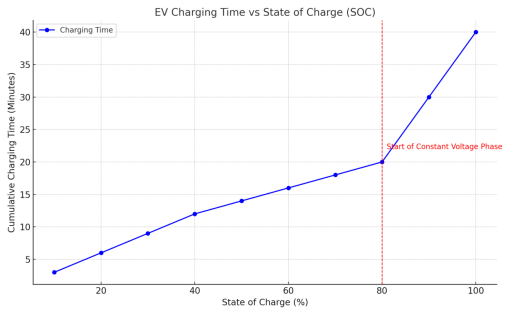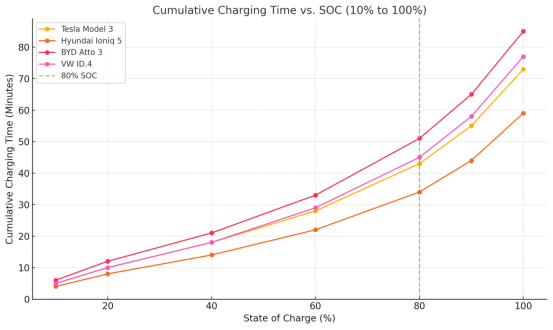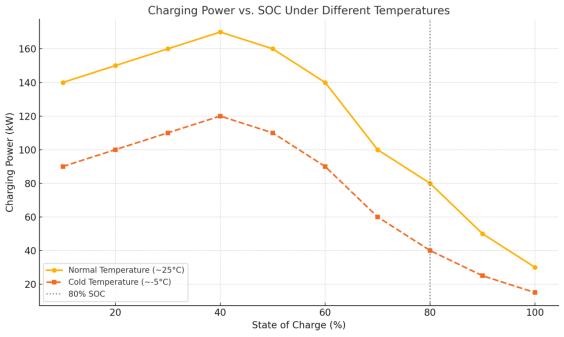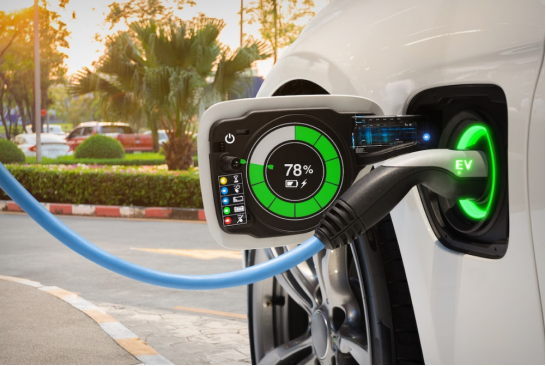Introduction
If you’ve ever noticed your EV charging much slower after reaching 80%, you’re not alone. This slowdown is a common feature built into most electric vehicles — and it’s not a flaw. In fact, it’s a smart system designed to protect your battery and extend its life. In this article, we’ll explain why charging speed drops after 80%, how it works, and what you can do to get the most out of your EV charging experience.Let’s dive into the science behind the charging curve, understand why 80% is key, explore other influencing factors, and learn practical tips for smarter and faster charging.
In short: Charging slows down after 80% mainly due to battery protection protocols like voltage limits, rising internal resistance, and thermal control. This slowdown is especially noticeable during DC fast charging. By understanding the charging curve and adopting optimal habits—like charging to 80%, using preconditioning, and keeping software up-to-date—you can extend battery life and reduce charging times.
Understanding the EV Charging Curve (Why Speed Drops)
Battery Chemistry & Internal Resistance
As the state of charge (SOC) increases, the internal resistance of a lithium-ion battery rises. This causes more heat and higher voltage inside the battery. To prevent damage, the Battery Management System (BMS) lowers the charging power.
At high SOC levels, the battery becomes more sensitive to overcharging. To reduce stress and avoid degradation, the BMS slows down the current input once the battery reaches around 80%.
Different chemistries like NMC and LFP exhibit varying tolerance to fast charging, which affects the ideal charging threshold.
Voltage Limitations & Saturation Phase
As charging nears completion, the battery enters the constant voltage phase. During this stage, the BMS limits voltage strictly and reduces current. This is known as the saturation phase, and it’s why the last 20% often takes as long as the first 70%.
For example, the Hyundai Ioniq 5 can fast charge from 10% to 80% in under 20 minutes, but it may take another 20+ minutes to reach 100%.
As shown in the graph below, charging time increases steeply after 80% SOC.

[Figure 1:Schematic diagram of a typical lithium-ion battery fast-charging power curve (the diagram is for reference only, the specific curve varies depending on the vehicle model)]
AC vs DC Charging – Why Fast Charging Is More Affected
To fully understand why charging slows after 80%, it’s essential to distinguish between AC (Alternating Current) and DC (Direct Current) charging methods, as the slowdown is far more pronounced during DC fast charging.
AC charging, commonly used at home or workplaces (Level 1 or Level 2), delivers electricity more gradually. The vehicle’s onboard charger converts AC into DC to store it in the battery. Due to its lower power output (typically 3.7–22 kW), the charging speed is limited from the start — and thus, the power taper above 80% is less dramatic and often unnoticeable to most drivers.
DC fast charging, on the other hand, supplies high-voltage current directly to the battery, bypassing the onboard charger. With power levels ranging from 50 kW to over 350 kW, it’s designed to rapidly charge an EV from 10% to 80% in under 30 minutes. However, as the battery approaches a high State of Charge (SOC), the system must slow down to prevent thermal overload and overvoltage — hence the visible “charging cliff” after 80%.
In simple terms:
–With AC charging, the slowdown near 100% exists but is mild and less time-sensitive.
–With DC charging, the system delivers high current early, then intentionally throttles above ~80% to protect the battery — making it the primary scenario where users notice the slowdown.
Why 80% is the Charging “Sweet Spot”
Understanding why 80% is considered optimal lays the foundation for maximizing fast-charging efficiency — both in terms of time and battery longevity.
Note:above we mentioned ‘80%’ is a generally applicable reference value, but the specific ‘sweet spot’ starting point (which may be 75% or 85%) will vary slightly depending on the battery chemistry, battery pack design (such as NMC vs LFP) and BMS strategy of different models. Please refer to your vehicle manual for specific recommendations.
Maximizing Fast-Charging Efficiency
The 10–80% range delivers the best efficiency for fast charging. It gives you the most range in the shortest amount of time. Beyond 80%, you wait longer for fewer extra miles.
For daily drivers or long-distance travelers, stopping at 80% and continuing to the next charger can be the fastest way to reach your destination.
Protecting Battery Health
Repeatedly fast charging to 100% can degrade battery health over time. That’s why most EV makers, like Tesla and Hyundai, recommend an 80% charge for daily use.
Charging to 100% occasionally (like for long trips) is okay. But staying below 80% can help extend the life of your battery significantly.
Other Factors Affecting Charging Speed
Charger & Vehicle Hardware Limitations
Your EV’s charging speed also depends on the charging station and vehicle hardware. If the charger shares power with other vehicles, your charging rate may drop. Your vehicle’s battery pack and onboard charger also have maximum power limits.

[Figure 2: Schematic diagram of the impact of charging pile power and vehicle hardware on charging speed]
This comparative curve clearly demonstrates how different EV models behave as SOC rises
Temperature & Environmental Conditions
Cold or hot weather can cause the BMS to throttle charging power. In winter, batteries need to warm up before charging at full speed. Charging speed can drop by 20–30% in cold climates.
Temperature also plays a significant role, as illustrated in the chart comparing normal and cold climates.

[Figure 3: Schematic diagram of the effect of temperature on the charging speed of lithium-ion batteries]
Software & Equipment Issues
Sometimes, outdated firmware, communication issues between charger and car, or worn-out cables can cause slow charging. Regular updates help avoid compatibility issues.
After understanding these indicators, we can optimize the charging experience through the following proactive strategies.
Beat the Slowdown: Practical Tips for Faster EV Charging
Even with today’s best practices, the final 20% of charging remains a technical bottleneck. Fortunately, cutting-edge innovations are already emerging to break through this limit
Master Your Charging Routine: Daily Habits for Speed & Health
Set your charging limit to 80% for daily use. Save 100% charges for road trips. Use your car’s app to precondition the battery before arriving at the charging station.
Picking the Powerhouse: How Charger Choice Affects Speed
Always choose high-power DC chargers (≥150 kW) with dedicated power modules when available. Avoid shared chargers (where power is split between vehicles) or aging units that may not deliver consistent power.
Software & Firmware Updates
Software compatibility between the vehicle and charging station is crucial for negotiation protocols (e.g., ISO 15118 or OCPP). Using outdated firmware may limit access to peak charging speeds or cause session failures. Ensure both EV and charger firmware are up to date to avoid bottlenecks.
While the above habits can maximize your current EV’s charging efficiency, the future holds even more promising breakthroughs
The Future of EV Charging: Beating the 80% Bottleneck
New advancements in EV technology are set to dramatically reduce charging times, particularly in the slow-charging phase from 80% to 100% state of charge (SOC). These innovations focus on improving battery performance, safety, and thermal control to enable faster and more efficient charging.To tackle the 80-100% charging bottleneck, the following technologies are emerging.
800V Electrical Platforms
By increasing system voltage to 800V, EVs can support higher charging power with less heat generation and energy loss. This enables ultra-fast charging speeds, allowing vehicles to reach 80% charge in significantly shorter times compared to traditional 400V systems.
Solid-State Batteries
Replacing liquid electrolytes with solid materials, solid-state batteries offer higher energy density and enhanced safety. They support faster charging rates and better thermal stability, especially at high SOC levels, reducing the extended charging times seen in current
lithium-ion batteries.
H3: Advanced Thermal Management Systems
Effective thermal control is critical to maintaining battery health during fast charging. New cooling technologies and intelligent heat dissipation methods keep batteries within optimal temperature ranges, allowing sustained high-current charging up to full capacity without degradation.
Intelligent Battery Management and Charging Protocols
Modern battery management systems employ adaptive algorithms that optimize voltage, current, and cooling in real time. This dynamic adjustment maximizes charging speed while preserving battery life, further minimizing the charging slowdown near full capacity.
FAQs
Q: Do all EVs slow down after 80%?
A: Most lithium-ion EVs slow down after 80%, but LFP batteries maintain higher charging rates until ~90%. Check your battery type in vehicle settings
Q: Is it safe to charge to 100%?
A: Occasionally, yes. But forcing it frequently increases battery wear and isn’t recommended for daily use.
Q: Does battery preconditioning really help?
A: Yes! In cold weather, preheating the battery can improve charging efficiency by up to 30%. Especially in winter, when using DC fast charging, the improvement is obvious
Q: Does this slowdown happen with slow (AC) charging at home too?
A: The dramatic power reduction seen in DC fast charging above 80% is primarily a characteristic of high-power charging. With slower AC (Level 1/2) charging at home, the power levels are much lower overall, so the relative slowdown near 100% is less pronounced and less of a practical time concern. However, the recommendation to limit daily charging to 80% for battery health still applies equally to AC charging.
Conclusion
The intentional charging slowdown beyond 80% state of charge represents a meticulously engineered battery safeguarding mechanism , fundamentally designed to balance charging efficiency with long-term battery longevity. By adopting daily 80% charge limits , strategically utilizing preconditioning features, and selecting high-power charging stations, you not only reduce charging downtime but also significantly extend your battery’s service life *— directly impacting your vehicle’s resale value. While emerging technologies like solid-state batteries and 800V platforms promise to alleviate the 80-100% recharging bottleneck,* smart charging habits remain your optimal strategy for today’s electric driving experience.
To get the most out of your EV’s charging capabilities, consider using chargers designed with battery health in mind. [Discover smart-charging solutions ➜]


